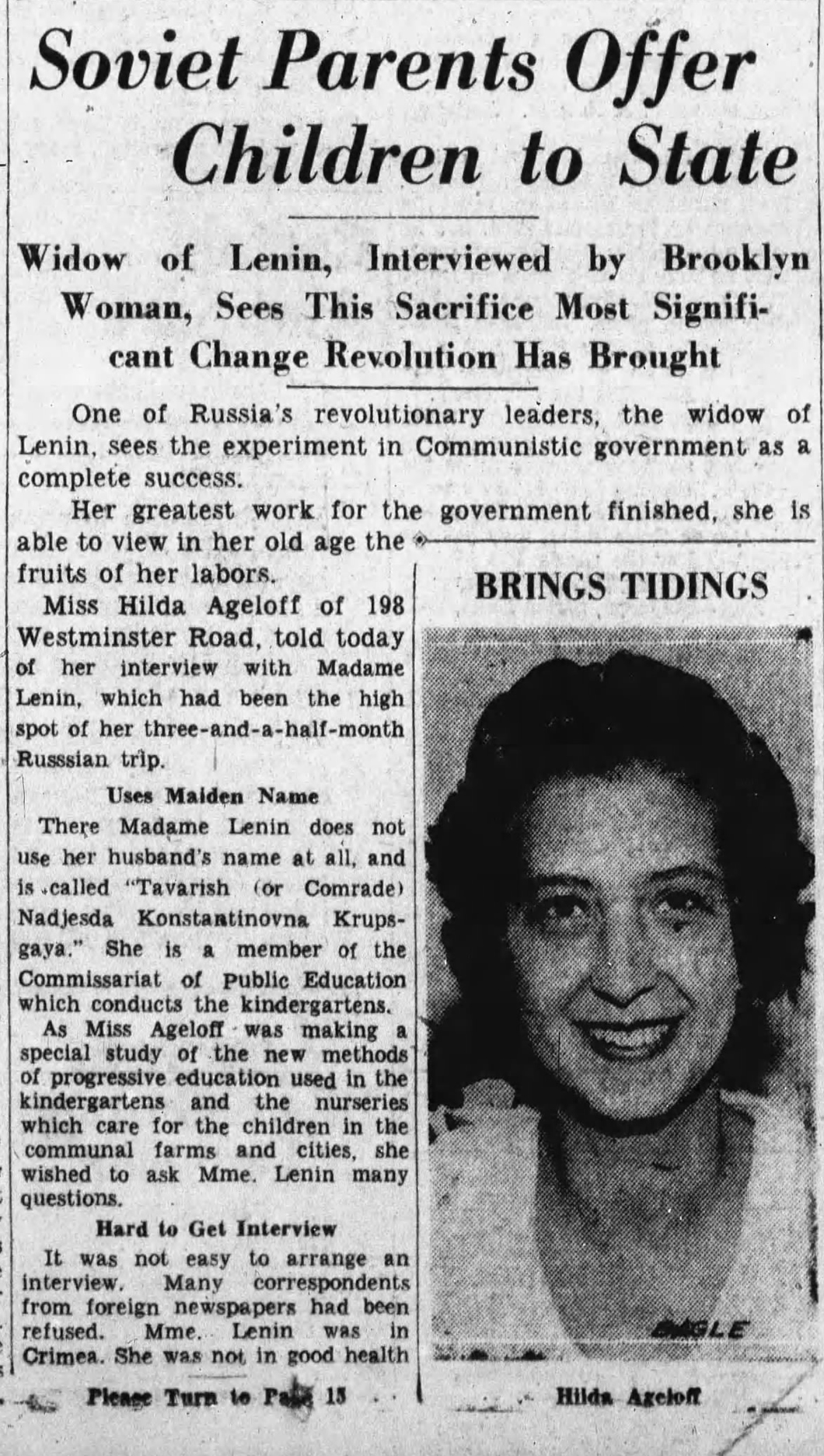Once there was a small monkey who lived in the same household as a little cat. When he saw some chestnuts buried in the hearth, he began to brush the ash aside, but, afraid of the burning coals, he seized the foot of the sleeping cat and with it stole them out.
- old french fable retold by Jean de La Fontaine "The Monkey and the Cat"
Leon Trotsky was attacked Aug 20, 1940 in Mexico City and died the next day. Sylvia was arrested immediately after the attack. On September 1 she was charged for being an accomplice. She was released on December 24th and returned home to New York immediately.
The published accounts of the Trotsky assassination are unanimous - Sylvia Ageloff was an innocent dupe of Jacques Mornard, or as she put it, a "cats paw".
AP story - Aug 23, 1940 -
George P. Shaw, the American consul, was permitted to interview Sylvia Ageloff. Shaw found her hysterical. Associates of Trotsky said they believed Miss Ageloff was an "innocent tool" of Jacson but Col. Deandro Sanchez Salazar, chief of secret service, said his investigation of the young woman was incomplete. The girl, who introduced Jacson to Trosky, insists she had no knowledge that Jacson planned to kill him or that she knew he was a Soviet agent.
Sylvia lived with Jacques in Paris 7-8 months in 1938, then 1 month in New York September 1939, then 3 months Jan-Mar 1940 in Mexico, then 2 weeks in New York latter half of June 1940, and finally from Aug 8 to 20 in Mexico. Levine probably has the most detailed account of Jacques shifty stories to Sylvia during these times. Levine is incredulous but accepting that Sylvia believed these unbelievable stories. Jacson didnt just fool Sylvia. Jake Cooper, guard at the compound, said "We must admit that he fooled us completely." (My Brother, My Comrade, Mark Harris, 1994)
Isaac Don Levine, The Mind of an Assassin, 1959 -
Ramon had all the prerequisites for such a masquerade. He was tall, handsome, well-bred, spoke French and Spanish perfectly, and English well enough to pass for an American. He was only 25, but looked a bit older. He could don the mask of well-to-do, glamorous aristocrat. The young woman chosen as the gull in the imposture was Sylvia Ageloff, a 28 year old social worker who lacked glamour. She was listed in the NKVD records as a Trotskyite courier and she may, indeed, have carried some messages from or for Trotsky on occasion in her travels across the Atlantic....she accepted these confused and and contradictory stories, perhaps because she wanted to believe in him and was afraid of the truth...Sylvia wishfully swallowed this preposterous story. Only a person totally blinded by love could make herself believe...Even less attention to details was paid by love-struck Sylvia.
Jacques told her he was a sports reporter, though Sylvia never saw him write or attend a single sport event. He said he came from a political family, though he had not the slightest interest in politics at a time when Europe was lurching toward war. She never met a single friend or acquaintance or family member. He got a job in America as a reporter, he said, but when he arrived it was a different job. He arrived on a fake passport and a new name. When he was supposedly buying and selling commodities, she never saw him do any work, never saw where he worked or saw any interaction with people connected to his work.
Isaac Deutscher, The Prophet Outcast, 1963 -
"A lonely spinster of rather unattractive appearance, she found herself all of a sudden assiduously courted by the handsome and well-groomed Mornard. She succumbed, and spent with him several absent-minded, dream-like months in France. Now and then she was puzzled by his behavior. He exhibited so complete a lack of any interest in politics that this seemed to amount to an indolence of mind, quite surprising in the educated ‘son of a diplomat’. He had impenetrably obscure connexions in commerce and journalism; even his family background was enigmatic. The stories he told her about himself were odd, even incoherent; and he spent lavishly, as if from a horn of plenty, on feats and amusements.”
Dmitri Volkogonov, Trotsky the Eternal Revolutionary, 1996 -
Sylvia’s mother was Russian and Sylvia, apart from English, French, and Spanish, also spoke Russian. In 1938 she met Jacques Mornard. He took the 28 year old Sylvia - who was not especially attractive - to restaurants and theatres, and proposed marriage. Jacques was good-looking and attentive, and not short of cash. She was head over heels in love, and with her help Mercader-Mornard-Jacson finally penetrated Trotsky’s household.
Both parents were Russian immigrants who spoke Russian. Her mother died in 1930. Her father was a wealthy real estate owner and building contractor in New York.
Bertrand Patenaude, Trotsky, Downfall of a Revolutionary, 2009 -
Jacques was tall, lean, and muscular with swarthy good looks. He took Sylvia to his favorite restaurants, always insisting on ordering the finest wines. The Belgian playboy intoxicated the homely Brooklyn social worker, and he seduced her.
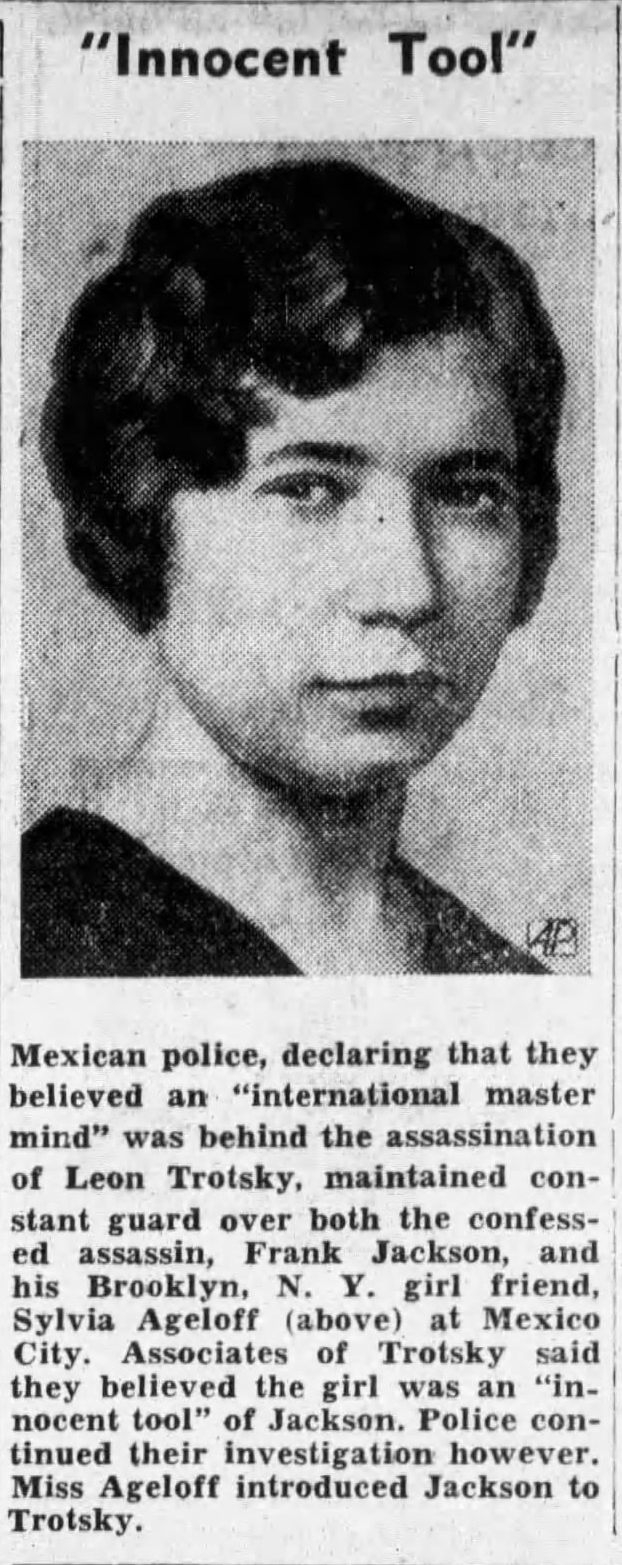
The setup to introduce Sylvia to the dashing Jacques in Paris varies by whoever is telling it, sometimes quite materially. Louis Budenz was a high flying communist editor of the Daily Worker in the 1930s from Indianapolis. He worked closely with NKVD agents. In 1945 he renounced communism and became a highly public informant for the FBI and House Un-American Committee hearings. He says he was the one who set the plot in motion. His account seems to be accurate, though how much is from his own experience and how much is second hand is a question. His account gives some consideration as to how the plot had to unfold and was not simply conceived all at once. I quote him extensively, with some condensing, as he tells the story simply without embellishment, and the details become important if the truth is to be known.
Louis Budenz, Men Without Faces, 1950 -
(P126) Ruby Weil was chosen by the secret (NKVD) police out of the party’s rank and file. The man in charge of secret work in New York, Comrade Chester, had selected her as a young woman with the requisite conservative background to act as a courier and in other secret capacities. She came from a respected family in the Middle West, successful in business and well regarded in community life.
Comrade Chester, an alien from Poland whose real name was Zuster, had noted her air of casual sophistication and had realized that she would know how to handle any social situation. He had drafted her for a secret training school for those who were to be called on to perform underground services.
It was while she was in this school that I approached her on behalf of Roberts. She had been a family friend before either she or I had joined the Communist party. What clinched her for Roberts’ assignment was that she had also been a friend of the Ageloff sisters, before she had been a Red.
There were three of the Ageloffs - Ruth, who became Trotsky’s secretary down in Mexico City, Hilda, who was Ruby’s particular friend, and Sylvia, a Brooklyn social worker who was a special courier of the Trotskyites into Canada, Europe, and Mexico. They were the daughters of a substantial building contractor.
When at Roberts’ advice, I told her what was required of her - to cultivate the Ageloffs in order to obtain information on the Trotskyites - she made excuses for declining. However, she finally agreed to see Roberts, and at that meeting he represented her obligation to be so urgent that she promised to follow his directions. This was in the summer of 1937.
After I got to Chicago, I was called back to New York time after time to prevent Ruby from throwing up her assignment. As Roberts unfolded to her a plan to send her to Europe with Sylvia Ageloff, who was attending the international Trotskyite conference in Paris, Ruby’s fears increased. On one occasion I was called to New York in great haste, and at Roberts’ instructions met Ruby late at night as she left her work at the People’s Press. Riding to the Grand Central Station in a cab, we had a bite to eat at Liggett’s drug store, and then for an hour I urged her to take the Paris trip. Both she and I had been told repeatedly by Roberts that our task was to halt the infiltration of Trotskyites into Soviet Russia and thus prevent Stalin’s assassination. Ruby’s attendance at the international congress would give her an opportunity to get at the roots of such plots. Neither of us suspected for a moment that we were engaged in steps that would lead to the killing of Trotsky in Mexico City.
Ruby was disturbed by the fact that mysterious plans of an elaborate nature had been made for her in the French capital. At the last minute, Roberts had said that he would not be there in person to direct her, and had sent her to a woman named Gertrude down in Greenwich Village. It was Gertrude who would be in Paris and tell her what to do.
Ostensibly, Ruby was going to Europe to visit one of her sisters in England, so it seemed natural enough that she should accompany her friend Sylvia - though as far as that aspect of it was concerned, she had already ingratiated herself with the Trotskyites by attending their affairs with the Ageloff sisters. While Ruby was stopping off in England, Gertrude reached Paris and was ready to receive Ruby on her arrival and introduce her to one “Frank Jacson,” known also as Jacques Mornard. Ruby in turn was instructed to introduce him as a Belgian count to Sylvia Ageloff. After this introduction, Jacson swept Sylvia off her feet with his attentions, pretending to fall in love with her at first sight.
George P. Shaw, the American consul in Mexico City, compiled this report (I excerpted) from police evidence and sent to Washington Sept 1, 1940. (published in "How The GPU Murdered Trotsky", 1975, New Park Publications, written and compiled by British Trotskyists under the banner "Security and the Fourth International")
Sylvia lived in New York until 1930, then in Europe, first in Spain, then in Italy and then was successively in Vienna, Austria, Germany, Switzerland, France, having resided two months in Paris studying at the Alliance Francaise, from where she went to London, where she was for one week then returned to Paris, from which she went to St. Malo and from there went to the English port of Southampton from where she went to Oxford University to take the summer course.
That this voyage just referred to was made in 1931, stating that in her journey from Spain to Italy she passed through North Africa; that in the same year she returned to Brooklyn, having remained in Europe eight months, then having lived in the country of her origin, in July 1935 she came to Mexico City, where she remained approximately one month without being able to state precisely if it was in this year or in 1936 that she returned to the United States, which country she left in 1938 to go again to Europe, having been one week in the year 1937 in Canada. After Europe she returned to the United States, having resided eight months in Europe, where she state she stayed until January of this year, when she again came to Mexico remaining until March, and returning to New York, returning to Mexico on August 9, 1940.
She stated that her father spent money on her education and subsistence and that she only worked in the years 1936 to 1938. That her first journey to Europe was paid for by a policy which her mother left, and as enough money was not available her father paid the rest. The second journey was paid for by her father. Her first trip to Mexico was paid for by her father and subsequent journeys were paid for by herself. She said she was a professor of Child Psychology and that her salary was $103 a month. Belonged to the Labor Party in 1935 and 1936 working in the field of propaganda. Stated she never visited Russia. Has no connection with political elements in Mexico except those which form a part of the Fourth International. Does not belong to the GPU.
With regard to activities of her sister, Ruth, five years ago to the present date came out of school and came to Mexico, remaining for the winter. Later returned to the United States where she studied stenography. Later, being in ill health, her father sent her to California, which di not please her. She returned to Mexico and offered to remain to take dictation from Mr. Trotsky, returning later to the United States.
The FBI checked out Sylvia's academic history. She got a masters in psychology in 1934 at the age of 25. Her thesis dealt with an individual's likelihood of trust depending on the prestige of the source. After her masters, she took 15 more classes in psychology in 1936-37. She was halfway or better to achieving a Phd.
(Fbi_3_57) - At the registrar’s office, Columbia University, Broadway and 116th Street, the clerk allowed Agent to review the student record card on Sylvia Ageloff. This card reflected she was born Jan 13, 1909 at New York City; that her father was Samuel Ageloff; that she resided at 167 Lenox Road , Brooklyn; that she received a B.S. from the Washington Square College of New York University in June, 1930; that she received an M.A. in Psychology at Columbia University on June 5, 1934; that she took post-graduate course, 13 in psychology and 2 in education at Columbia University, 1936-7, in which she made good grades. It should be noted that the title of her thesis for her M.A. Degree was entitled “A Study of ‘Prestige’ and ‘Objective’ Factors in Suggestibility in a Comparison of Racial and Sex Differences.”

The online FBI Trotsky case files are separated into 5 PDF files. My notation is (1_113) for 1st File, page 113
FBI Vault Trotsky Files(FBI 1_117) - Aug 23, 1940 - Memorandum, appears to be the results of an interview of Sylvia Ageloff by Special Agent in Charge (SAC) Gus T. Jones, who was running the investigation in Mexico City. Jones was a legendary FBI man, the San Antonio chief agent. The file is heavily redacted.
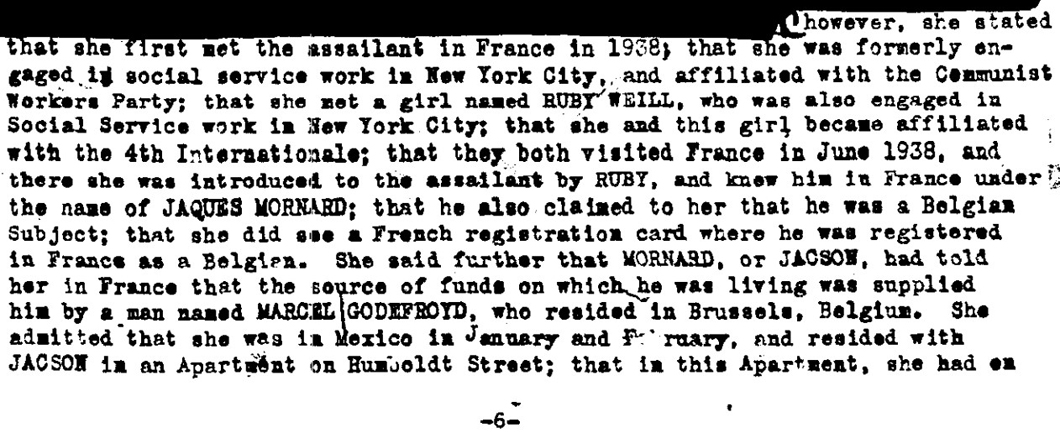
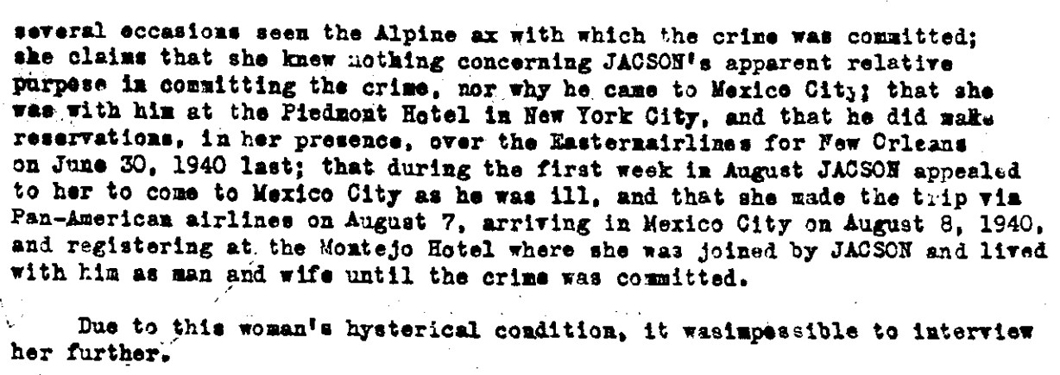
Due to this woman's hysterical condition, it was impossible to interview her further.
(FBI 1_169) - Aug 27, 1940 - memorandum, appears to be the results of the second interview of Sylvia Ageloff by SAC Gus T. Jones. The file is heavily redacted.


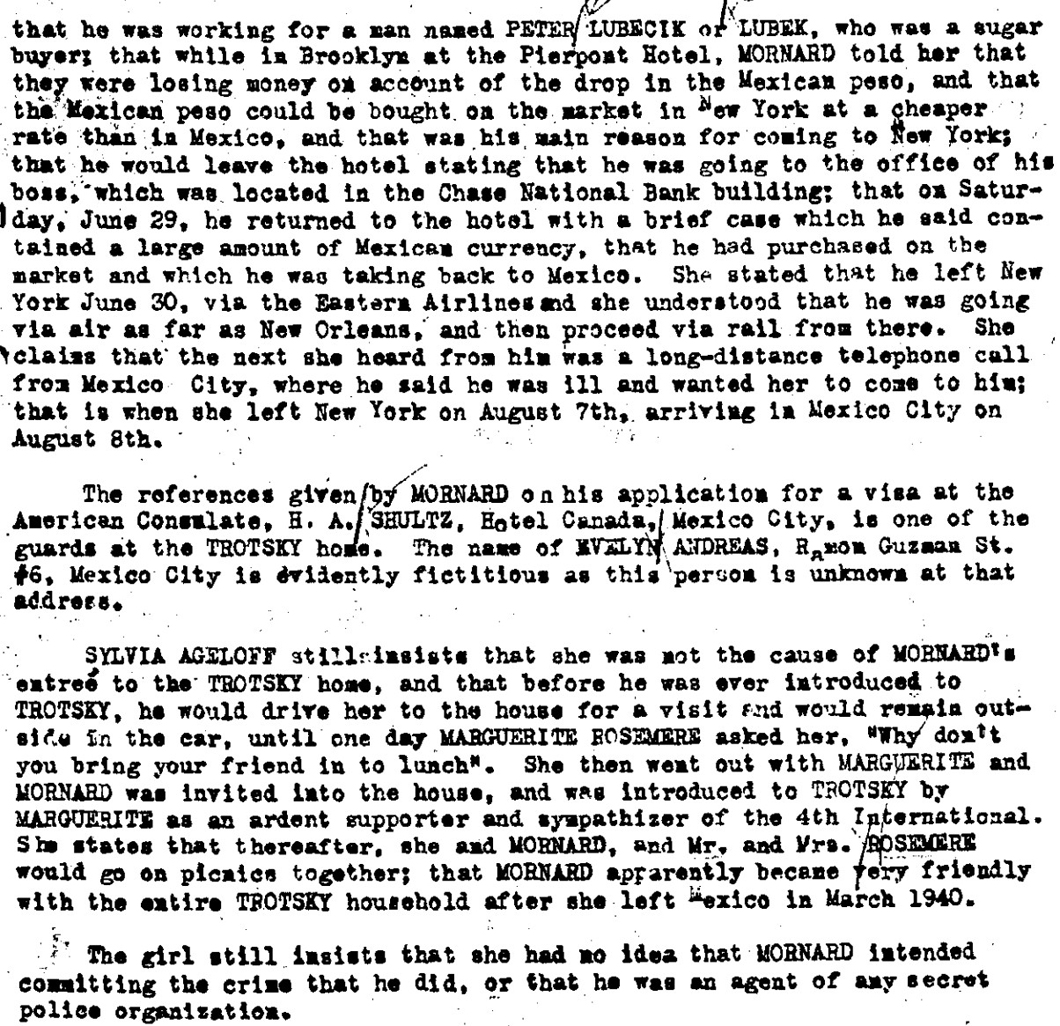
Sylvia Ageloff still insists that she was not the cause of Mornard’s entry to the Trotsky home, and that before he was ever introduced to Trotsky, he would drive her to the house for a visit and would remain outside in the car, until one day Marguerite Rosemere asked her, “Why don’t you bring your friend in to lunch.” She then went out with Marguerite and Mornard was invited into the house, and was introduced to Trotksy by Marguerite as an ardent supporter and sympathizer of the 4th International. She states that thereafter, she and Mornard, and Mr. And Mrs. Rosemere would go on picnics together; that Mornard apparently became very friendly with the entire Trotsky household after she left Mexico in March 1940.
According to the FBI interview of Sylvia (that probably took place in the hospital), Marguerite Rosmer suggested Jacson come inside the compound after repeated visits where he hangs out outside. This started in the January-March period when both Sylvia and the Rosmers were in Mexico. Sylvia is the one according to her own interview, who introduced him to the interior of the compound by bringing him around and having him visibly wait just outside. After Sylvia leaves Mexico in March, Alfred Rosmer becomes sick and Jacson becomes his friend ever-willing to lend a ride and help him back to his room. This is how he became so well known to the guards and able to pass the gate routinely. He entered the garden probably multiple times before the first attack on May 24. A lot of accounts state that Jacson did not enter the compound for the first time until May 28, when he drove the Rosmers and Natalia to Vera Cruz, but this is based solely by looking at the guard's visitor log, which probably was not rigorously kept - before the May 24 attack - for transient visitors who were merely waiting inside or picking up the Rosmers.
When Jacson wished to return to New York in June, he had to apply to the America consulate for a visa. He claimed he was returning to his home in Canada and applied for a transit visa. Hank Schultz was in charge of building up the compound's defenses. Evelyn Andreas would later call herself Evelyn Reed. Jacson got to know her very well on the Vera Cruz trip, because she was the driver of the second car, which supposedly developed car trouble and had to be left at a repair shop. Jacson befriended all of them and spent considerable time in the apartment where Evelyn and the Schultz's were staying.
(FBI 1_137) - Aug 29, 1940 - memorandum, stated third interview of Sylvia Ageloff by SAC Gus T. Jones. The file is heavily redacted.

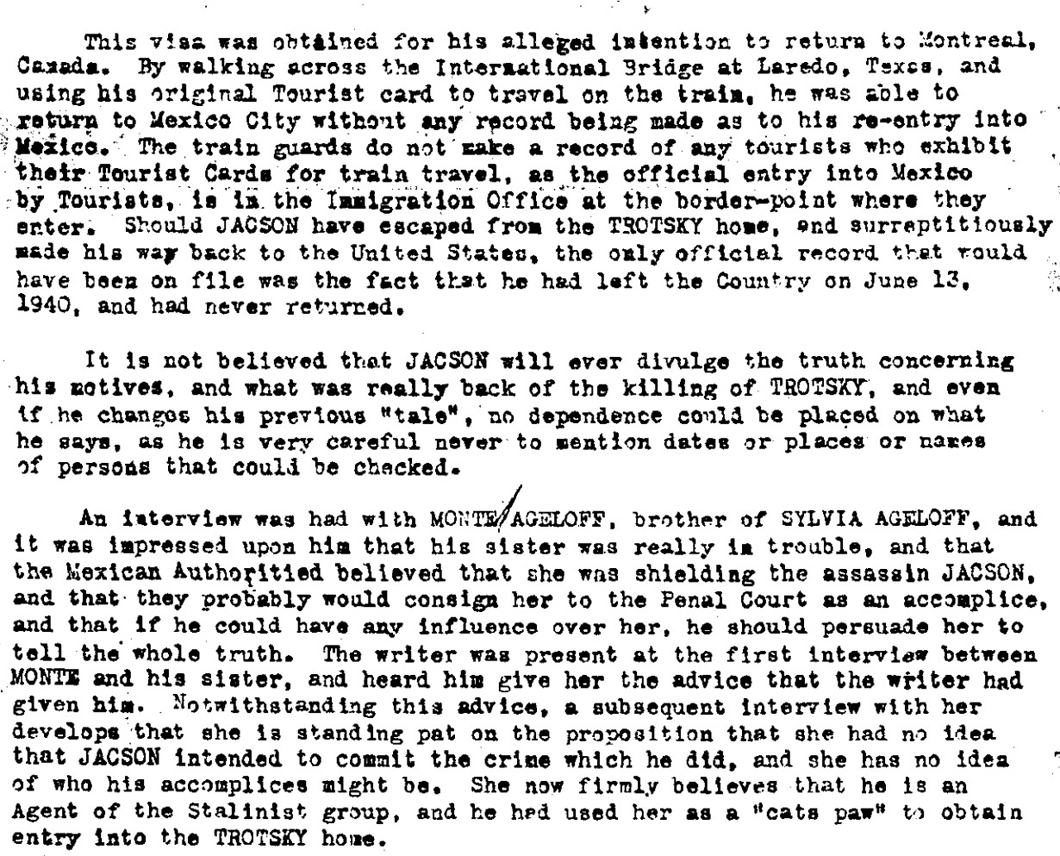
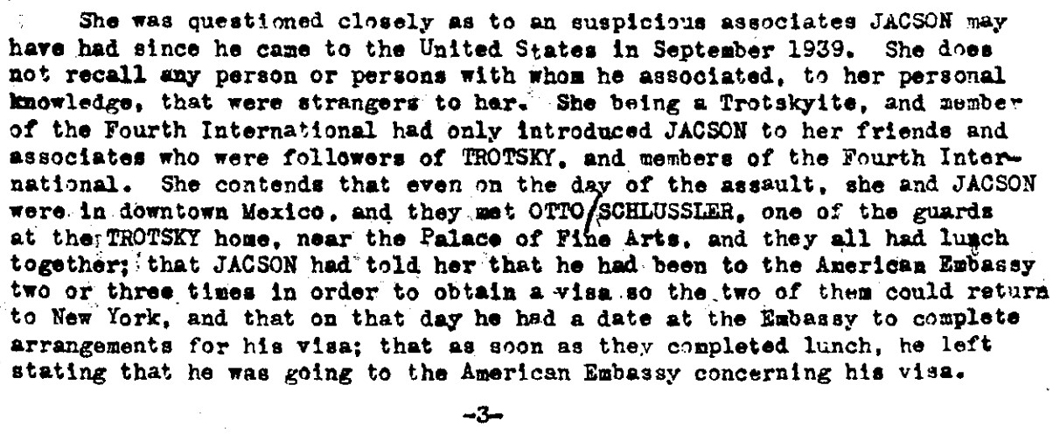
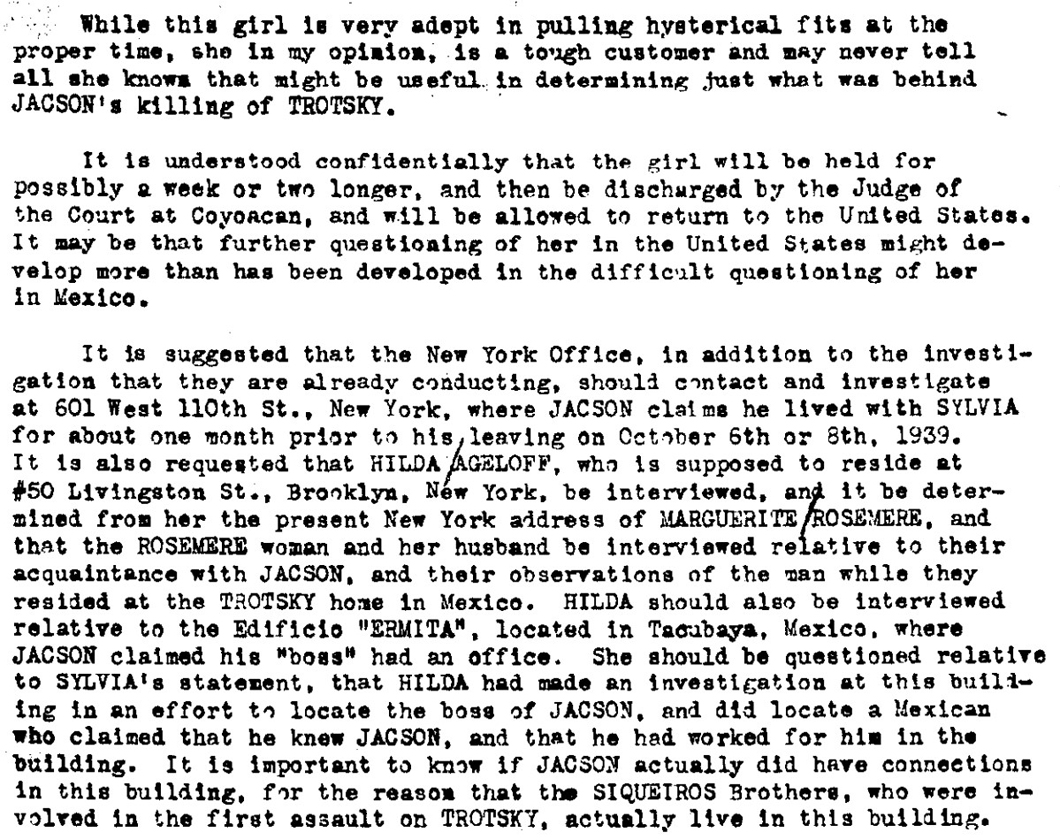
While this girl is very adept in pulling hysterical fits at the proper time, she in my opinion, is a tough customer and may never tell all she knows that might be useful in determining just what was behind Jacson’s killing of Trotsky.
It may be that further questioning of her in the United States might develop more than has been developed in the difficult questioning of her in Mexico.
She now firmly believes that he used her as a "cats paw" to obtain entry into the Trotsky home
Gus T. Jones says Sylvia is a tough customer. Jones had a lot of experience with tough customers. Here is a link to a biography of Jones, its about halfway down.
Gus T. Jones bioJones suggests interviewing Hilda and the Rosmers. Why is Hilda in Mexico at the same time as Sylvia? There is no indication in the FBI file either of these interviews were ever done. The Rosmers were essential to getting Jacson into the household. When Jacson drove them to the ship in Vera Cruz, and Natalia Trotsky went along, from that moment on it must have seemed to the guards that Trotsky trusted Jacson. The Rosmers went supposedly to return to France, although France was at war and fell practically as they landed in New York. Like Ruby Weil, the FBI file shows no attempted interview. If they became informants, it seems likely those interviews would not be released or be redacted.
On Aug 31, 1940 Sylvia was formally charged with complicity by the Mexican justice system.
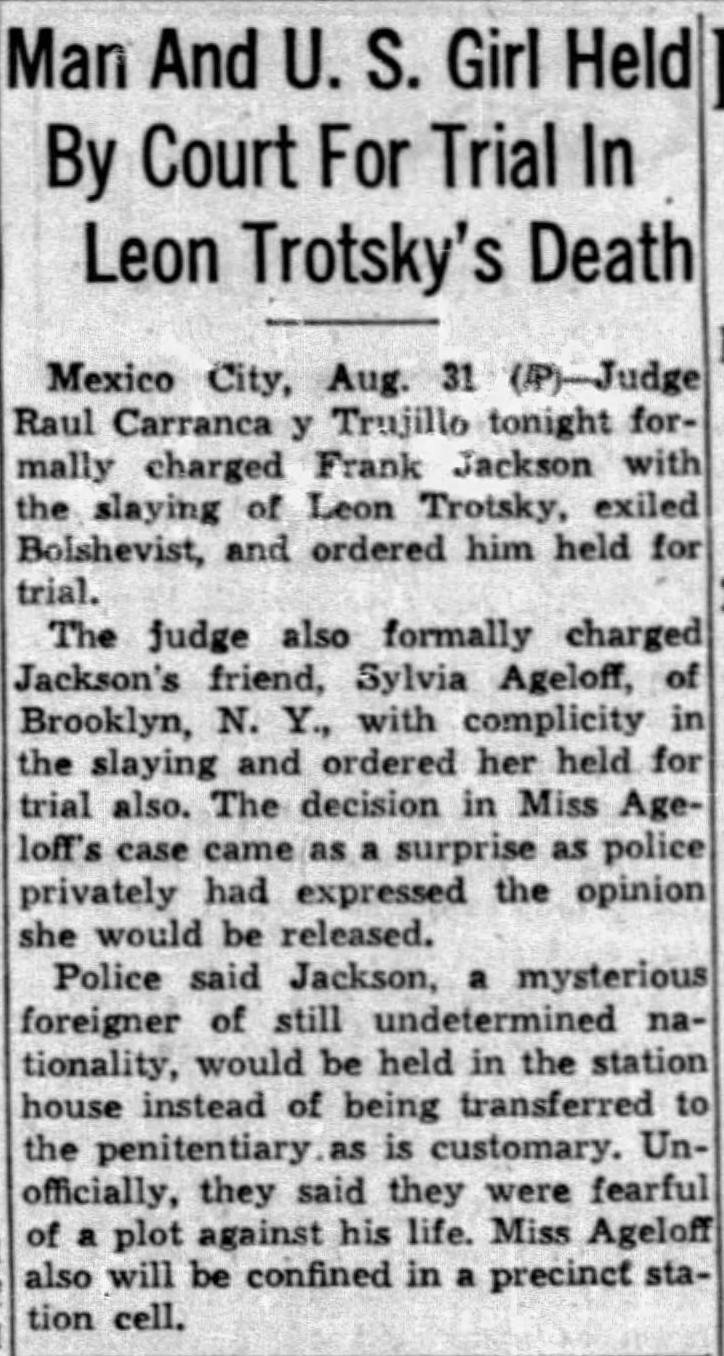
Albert Goldman was Trotsky's lawyer and a top guy in the SWP. The justice system in Mexico does not use a courtroom scene with all parties present, no jury, no cross-examination. The judge runs his own inquiry and makes a decision. The judge for Jacson and Sylvia allowed Goldman to interview Jacson. Goldman wrote a 74 page account of his statements and compiled other data from the case. Goldman never says he explicitly interviewed Sylvia. Goldman as early as Aug 25 is quoted in the press saying "he was convinced Sylvia had no part in the assassination." Goldman's compiled "Testimony of Witnesses" section of 5 pages is the source that most authors use to describe the relationship between Sylvia and Jacson.
The Assassination of Leon Trotsky, the Proofs of Stalin's Guild, Albert Goldman, Oct 11, 1940
(P14) In the latter part of July 1938, he informed Sylvia that his parents had been in an automobile accident and that he must leave for Brussels immediately. Sylvia went to Prague and on the way back to Paris, stopped off at Brussels, intending to meet Mornard there. Instead, a woman met her at the place where she was supposed to meet Mornard, and told her that Mornard had been suddenly called away to England. Sylvia came back to Paris without seeing Mornard, and while in Paris she received letters from him. He returned to Paris some time in September 1938 and told Sylvia that he had been in Brussels all the time, but was under military arrest because of his failure to serve in the army.
Sylvia and Jacson meet possibly July 1, 1938. On July 13, Rudolf Klement disappears. He is the secretary-to-be of the incipient Fourth International. On July 26 a torso is found floating in the river Seine in Paris, thought to be Klement. It was a sensation in Paris. It made headlines all over America on Aug 30. Jacson also disappears in July, and Sylvia suddenly goes to Prague, a trip no one explains. What business would a 29yr old Jewish woman from Brooklyn traveling alone have in Prague, Czechoslovakia in the summer of 1938? They both return to Paris in time for both to attend the all-important to Trotskyists founding of the Fourth International on Sept 3, 1938, at a secret location, the Rosmer's house. Sylvia takes Jacques. The first order of business is mourning Klement and Trotsky's son, both killed in Paris that year. Jacques hangs around outside but he later says he met Cannon in Paris. I am not sure what the source is for him being there, but almost all the authors use it. If true, Sylvia despite being lovestruck brought a guy she just met who is a black box. Does Sylvia ask Jacques who was the woman who lied to her in Brussels?
Levine says "She later testified that she had not even known of the meeting in advance, and had decided to go abroad on her own, solely for pleasure. A key factor in these preparations for the Trotsky murder was that the Soviet secret service overestimated Sylvia Ageloff’s participation in the Trotsky movement and her importance in it.”
(P15) When Sylvia told him that she could not remain in France without working, he arranged to have her write articles on psychology, which he claimed he sold to an Argus Publishing co., a company that sold articles on various subjects to different magazines. He gave her 3,000 francs a month for the articles that she wrote, but refused to put her in touch with the Argus Publishing co. And refused also to show her any magazines where her articles were published, claiming that such was the rule of the company.
(P15) Sylvia left Paris for New York in February 1939. According to word received from Jacson, he was supposed to come to New York in March 1939, claiming that he had obtained a position as an American correspondent for a Belgian newspaper. However, he sent a cable to Sylvia announcing that he could not come, and later, by letter, informed her that the reason for his inability to come was that he could not get an American visa.
(P15) Jacson arrived in New York in the early part of September 1939, and told some members of the Ageloff family that in order to leave Europe he had to obtain a false passport, because of mobilization, and that he had bought a Canadian passport from some passport service in France for the sum of $3500. He claimed to have obtained $10,000 from his mother. He also told them that he had a position working for a broker operating in Mexico and purchasing different materials for England and France.
(P16) (In Mexico Jan-Mar 1940) On different occasions Sylvia asked Jacson where his office was and he told her it was in Room 820 of the Ermita Building. One day Sylvia’s sister went to look for him in that building, and found that there was no such room. Jacson explained that he had made a mistake in the room number, and that it was Room 620 instead of 820. Sylvia became suspicious about the nature of his work, and asked Marguerite Rosmer to find out whether Jacson actually had an office in Room 620. Marguerite Rosmer went to the building and actually found an office boy in this room who told her that it was Jacson’s office. (Later it turned out that this room was used David Alfaro Siqueiros, organizer of the May 24th assault on Trotsky).
Neither Sylvia or Marguerite Rosmer then had any suspicion he was a GPU agent they thought that he was involved in work which was not strictly legal and that he consequently refused to divulge its nature.
Why was Sylvia's sister in Mexico the same time as Sylvia? The FBI found a postcard in Jacson's trunk addressed to B. Maslow in Tacuba, but there is no follow-up. Maslow was Sylvia's mother's name. Did Sylvia ask her husband-to-be what illegal busines is he in?
In the hindsight of 80 years, Goldman's text is contradictory. He uses the guard log to show that Jacson was only inside the compound 10 times, all after the May 24th assault, sometimes for only a few minutes, but how did everyone come to know him so well if that was the case? He says Trotsky several times asked guards to try to educate him, and yet Trotsky only met with him a handful of times. Why would Trotsky allow his wife to be driven 600 miles over 3 days just 4 days after almost being machine gunned with someone he only just met who had never been inside the compound until the day of departure? The reason I believe is that Goldman doesn't realize how many times Jacson stood in the yard during the period January-March 1940, picking up the Rosmers. Sylvia herself slips up and admits this to the FBI. Rosmer goes to the doctor and hospital in Jacson's car. Picnics, dinners. The woman who called Jacson so much at the Shirley courts where he lived was Marguerite Rosmer, the FBI determined. She was arranging rides. Once Jacson was in the habit of breaching the gate to help them back to their room, or just to stand and wait in the garden, he was free to chat with the guards. Lots of security measures were started after the machine gun attack, the meticulous keeping of the log was probably included in that.
Sylvia spent nearly the entire time of her incarceration in the hospital. She had a nervous breakdown which included a short-lived but publicized hunger strike. The Gotham Gossip columnist Dorothy Kilgallen said rumors were that her father had spent $100,000 in legal expenses. In November the Judge ruled her to be released due to lack of evidence, but the prosecutor had to sign off, and he would not. This prompted Goldman and Natalia Trotsky to appeal for her release. She finally was released Dec 24.
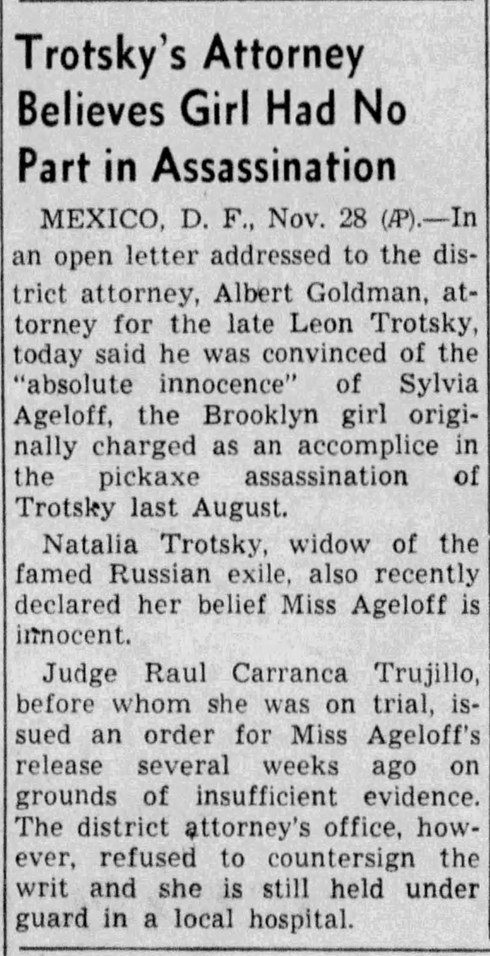
Upon arriving home, Sylvia evaded the press and gave no interviews. She released a short statement through her father's office, then she quickly faded out of the news.

The FBI chose not to interview her, but they watched her, tried to develop informants who could report her movements. They talked to her brother who said her health was very bad and she was not available for any interview. A year later, March 2, 1942, the assistant FBI director Foxworth writes "inasmuch as nothing has thus far been developed in this case, an interview may prove of paramount value." (Fbi_3_33) A few months after the interview Foxworth wrote the interview "has proved of relatively negative value," (3_74) and the FBI case of "Jacques Marnard Van Dendresced, with aliases" was officially closed. The interview is contained in a longer 12 page memorandum which is a summary of the investigation (Fbi_3_55)
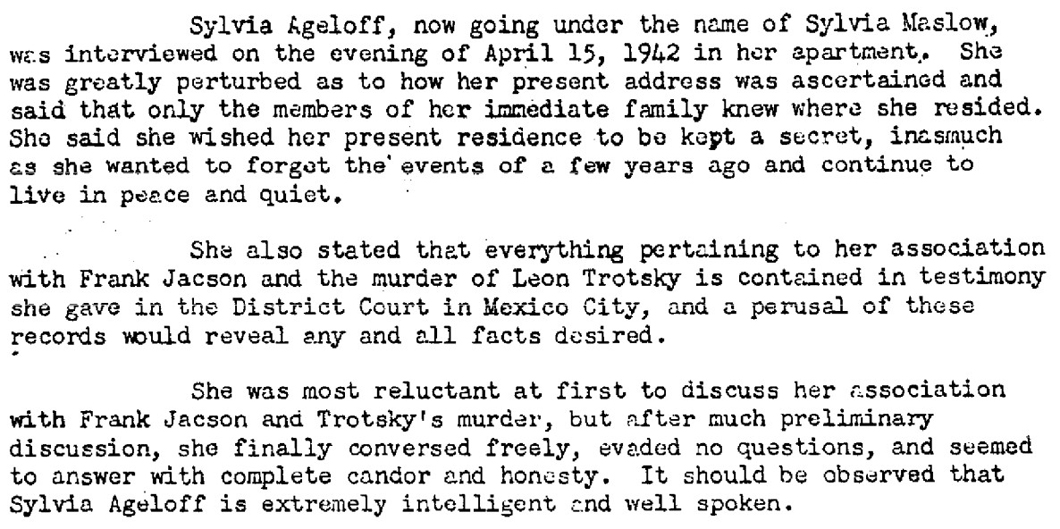

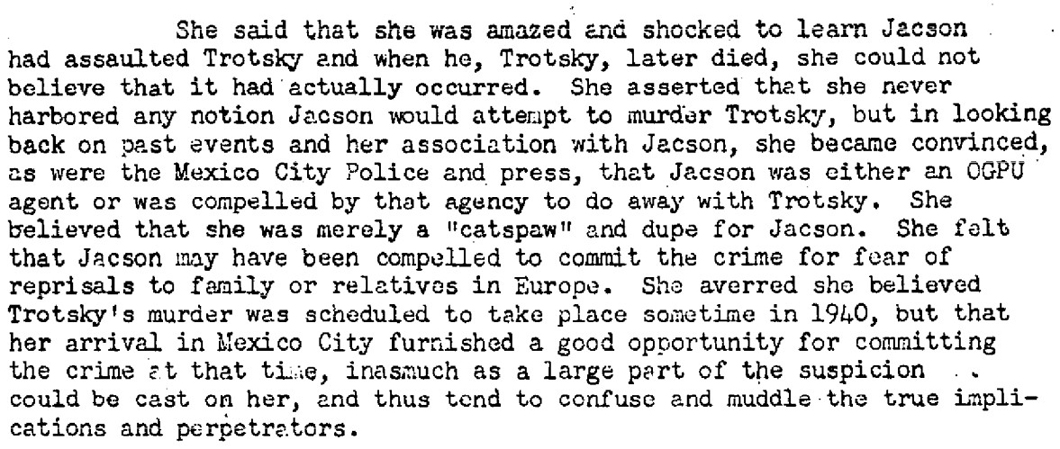


It should be observed that Sylvia Ageloff is extremely intelligent and well spoken.
She said she never joined the Socialist Workers Party, never became a dues-paying member, nor did she ever hold any office. She declared that she merely read literature published by the Socialist Workers Party and attended meetings and affairs sponsored by it for the public at large.
During the whole time she knew Jacson, she stated, he never once made any false moves...
The foregoing interview with Sylvia Ageloff was made hurriedly, inasmuch as it was conducted after the terminaton of her afternoon class, at 5:30 PM, and lasted for 2 1/2 hours, until she said she had an engagement for that evening and could talk no longer.
Sylvia stayed out of the news until 1950 when she and Hilda and Ruby were called to testify before the House Un-American activities committee. There wasn't much to report and the press ignored it. Red China was sending thousands of troops into Korea and American troops were in danger of being trapped. Sylvia and Hilda were the only witnesses who showed up without a lawyer and received a personal thank you from the committee, prompting speculation they were providing information behind the public hearing. Ruby showed up without a lawyer also, but she did not get a thank you. The other witnesses were involved in the mail drop operation to try to free Ramon Mercader from jail.
American Aspects of Assassination of Leon Trotsky Hearings HUACWhat is the bottom line? The official story is that Sylvia was a dupe. She certainly was not stupid or unsophisticated. Jake Cooper said Jacson fooled us completely. Jacson had drinks with James Cannon. Trotsky allowed him to drive Natalia to Vera Cruz and back. If Sylvia had been forthcoming, that would be the end of the story. But from the beginning she acted as if she were afraid her story would fall apart if she talked. Sylvia taking Jacques to the founding Fourth conference seems so unnatural that she was probably not who she said she was. But that is a very thinly sourced event. If it did not happen it would help her case some. A normal person, though, will have a hard time coming to any conclusions when probably the Russian and American governments are still withholding information. Not to mention the SWP. The full and total disclosure of unredacted files of the FBI and American State Dept, including the release of informants, might be all that is needed. But that involves the transparency of government, which is out of style, even if democracy demands informed voters. If those were available, though, there would be fewer questions.
Eric London's essay got me thinking about this. For a more detailed and critical look at Sylvia Ageloff's remarkable role, see
Sylvia Ageloff and the assassination of Leon Trotsky, Eric Londonalso good
Thinking with Sylvia Ageloff, Eric M. GurevitchThe Brooklyn Daily Eagle, 1931 Sept 02
